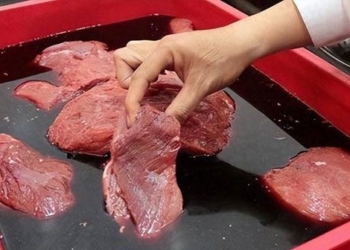On October 17, Dr. Nguyen Minh Tien, Deputy Director of Children’s Hospital City (Ho Chi Minh City), stated that there are two main groups of causes leading to milk poisoning.
- The first is bacterial contamination of milk. When the packaging is torn, punctured, leaking, or if the milk is past its expiration date, or stored in unsuitable conditions, it can become contaminated with bacteria such as Staphylococcus, Salmonella, E. coli, or fungi, leading to poisoning.
- The second group consists of milk with toxic substances that has not been tested for safety, with unclear origins. Milk that is formulated with excessively high ingredient levels or made from ingredients that have been stored for too long can lead to degradation and poisoning.
Symptoms of milk poisoning may include: abdominal pain, vomiting, diarrhea… In more severe cases, individuals may experience coma, seizures, or acute respiratory failure.

Do not use powdered milk when it is clumped or discolored. (Photo: LE CAM).
“As soon as symptoms of poisoning are noticed, it is important to quickly take the child or patient to a healthcare facility. During this time, it is advisable to supplement with water and oral rehydration solutions to replace fluids and minerals lost due to vomiting and diarrhea,” Dr. Tien shared.
To reduce the risk of milk poisoning, Dr. Tien advises parents to choose milk from reliable sources, that has been quality tested, with a long shelf life, and bears a safety seal. Additionally, depending on the child’s milk consumption level, small 450g cartons can be chosen for use within 1-2 weeks. For older children who consume larger quantities, if using 900g milk, it should be used within 2-4 weeks or according to the packaging recommendations. It is not advisable to use it for more than 4 weeks after opening the carton.
“Some signs of bacterial contamination that parents should pay attention to are clumping, loss of smoothness, and color change…” the doctor shared.
According to the recommendations of the Food Quality Management Department, Food Safety Management Board of Ho Chi Minh City, when purchasing various types of milk and milk products that are canned or packaged, we need to pay attention to the production and expiration dates. Additionally, it is essential to check to ensure the product’s packaging is intact, not dented, swollen, rusty, or has indentations.
Purchase products from stores that meet safety standards, such as: Products should be placed in a cool, well-ventilated area, not displayed directly under sunlight, and not stacked too many cartons of milk on top of each other or other products on top of cartons of milk; for yogurt products, storage conditions must comply with the manufacturer’s requirements.





















































